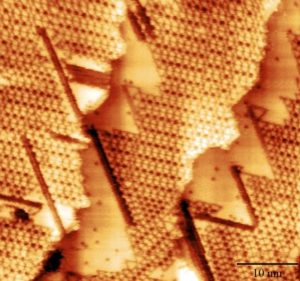
Areas of Interest
- Surface Chemistry of Metals and Metal-Oxides
- Oxide Thin Films
- Reaction Kinetics
- Molecular Catalysis
Our Research Goals
Our research focuses on enhancing the understanding of reactions occurring on solid surfaces on a molecular level. Further, we aim to identify favorable reaction pathways that can be implemented on such surfaces to create value-added products such as olefins. Such reactions are fundamental to heterogeneous catalysis yet remain poorly understood at the molecular level. We investigate surface chemical reactions using a wide collection of analysis methods based on ultrahigh vacuum (UHV) surface chemistry and physics. Mass spectroscopy is employed to ascertain information about surface reaction kinetics as well as adsorbed intermediates. We use low-energy electron diffraction (LEED) and scanning tunneling microscopy (STM) to determine the atomic-scale surface structure of our catalysts. X-ray photoelectron spectroscopy (XPS) is used to ascertain the chemical states of adsorbed molecules and atoms of the solid.
 We study the solid surfaces of single crystals with specific surface facets to better understand the role of surface structure regarding reactivity and selectivity of wanted products. We study a variety of different metals along with different surface facets of each metal to find the most stable, conformal oxide structure. Collaborators use molecular models to identify the most reactive oxide facets for us to explore experimentally.
We study the solid surfaces of single crystals with specific surface facets to better understand the role of surface structure regarding reactivity and selectivity of wanted products. We study a variety of different metals along with different surface facets of each metal to find the most stable, conformal oxide structure. Collaborators use molecular models to identify the most reactive oxide facets for us to explore experimentally.
The image on the left depicts the AgOX surface, taken using scanning tunneling microscopy. We are currently identifying different surface facets that the oxide forms to determine which is the most stable and which is the most reactive towards the partial oxidation of alkane adsorbates. This is just one representation of the capabilities we have for the exploration of solid surfaces.
In addition to internal experimentation, we perform external ambient pressure x-ray photoelectron spectroscopy (APXPS) experiments which allow us to probe reaction products at near ambient pressures at varying stages of the reaction. These experiments are performed at synchrotron facilities, including the National Synchrotron Light Source at Brookhaven National Laboratory in Brookhaven, New York and Max IV in Lund, Sweden.
